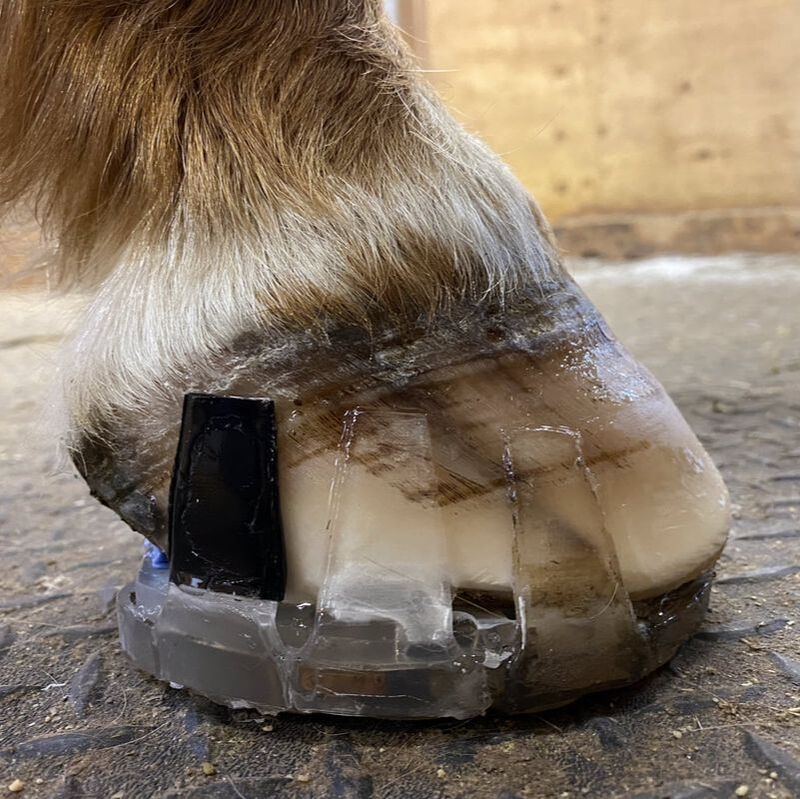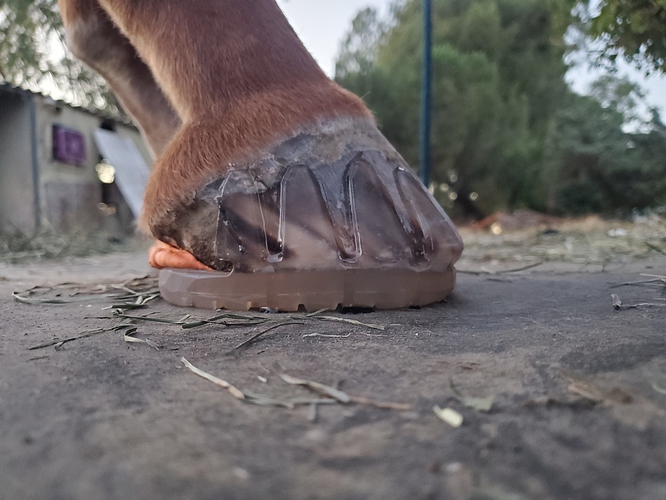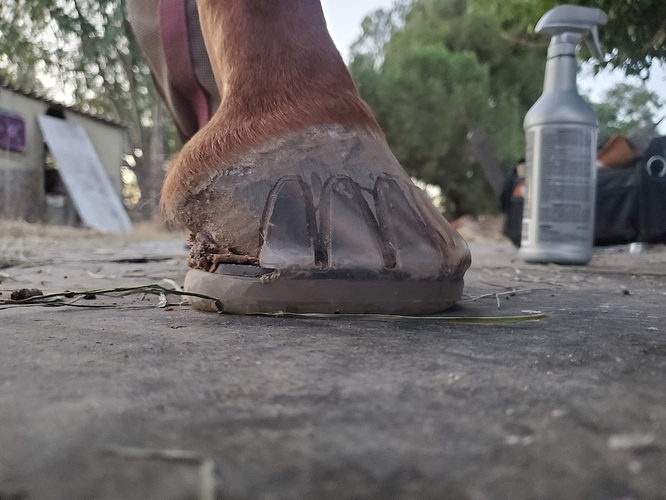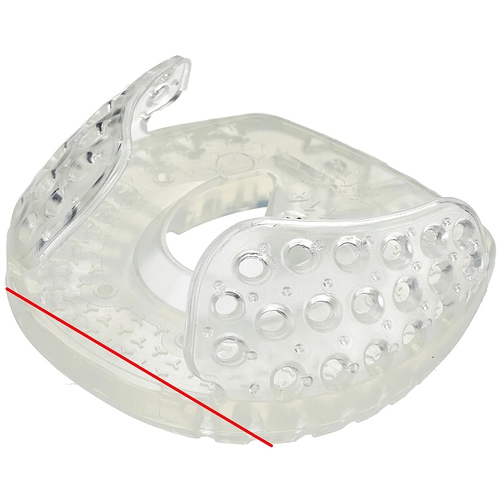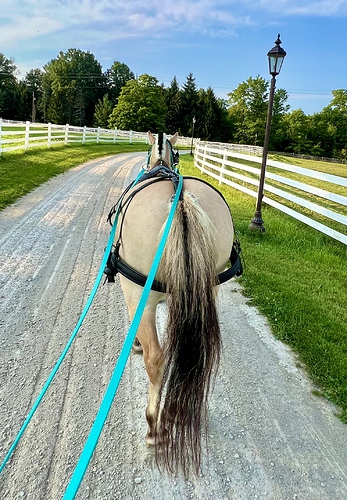Dang! My old guy had the same glue ons as yours for awhile and his had a good breakover. I wish I had pictures but I don’t. I see so many similarities between how my guy and yours move so I’m following this closely.
Heartland Docs. Found it if anyone wants to check it out.  This last season’s episodes.
This last season’s episodes.
When we put them on, she did a teeny bit of breakover; I think wanted to see how that would work for him and then adjust from here. Adding more if we do another set shouldn’t be a problem.
Thinking about the propensity for tripping in the Scoot Boots when he was barefoot; those seem very flat to me and could have been a contributing factor with the excess weight and tripping. That will probably mean we will need shoes in some capacity. I very well may learn to do the glue ons myself if they are something we keep on for a while.
I tried to find some internet pics, none of them are perfect but they give an idea.
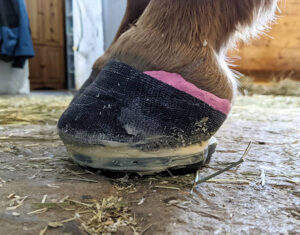
This is probably the best photo for showing how far the toe should be sticking over.
This one isn’t quite forward enough for your horse, but the shoe style is closer to what he is currently in so I thought I’d include it.
I drew on one of your photos to show how far I’d have his toe sticking out. The farrier could also rasp a rocker into the front of the shoe for even more effect, but I’d probably do that one or two trim cycles down the road; I don’t love changing too many angles too fast because IMO the leg ligaments need time to adjust to changes.
This is perfect, thank you so much!! And very close to what I was thinking.
In theory, could one set the shoe closer to the toe but rasp a more aggressive breakover into the shoe? Thinking for a case where the foot shape doesn’t allow that much toe to “stick out” and still maintain wall contact with the cuffs/tabs.
I know they make a rocker attachment for Versas that give more material to cut an aggressive breakover into, if needed. I’ve mainly seen it for rehab cases where there is a crazy amount of runaway foot, but they say it can be customized easily.
I don’t see why you couldn’t (though with the amount of material you need to remove, using a paint stripper wheel on a power tool would probably be needed).
You could also cut off some of the front of the shoe so the toe sticks over, which might actually be easier than trying to get the angles to match up grinding them down
Loving this discussion.
We did a 1.5 mile ground drive today and no trips! Driveway, grass trail, and through a pasture with several hills. I’m going to stay off his back until he drops a little more weight. I want to ground drive a few more times before getting the cart out, but hopefully this will be a good way to help him get better conditioned and not make things any worse on him.
Pony butt tax:


I don’t mind how your responses are posted 
The set back shoe with break over is how natural balance shoes are set as well. My guy was longer toed last summer when I kept him at the barn where I had bought him for a few months and he would trip every so often- an actual toe catch trip. As soon as I got him home, we gradually moved him to a shorter toe and the Avantis which helped significantly.
I don’t see why you couldn’t, it just might affect durability of the shoe. You can also trim breakover further once the shoe is on, using a rasp (RIP shoulders and elbows but it’s doable) or angle grinder. My first port of call would probably be trying to heat fit the tabs–soften/warm them with a torch or heat gun until they’re more translucent, then place on the foot and set back as needed. Hold the tabs there with a leather glove/hoof pick/insert item of choice while they cool, rinse and repeat as necessary.
What beautiful grass you have  we are in a drought here.
we are in a drought here.
Long lining that far sounds like my version of hell  but I’m sure it’s very good for both horse and rider (walker?)
but I’m sure it’s very good for both horse and rider (walker?)
We’ve had just enough rain to keep things from getting too dry this year, and temps have fluctuated quite.bit. I LOVE how it looks, its a bummer we are relegated to the drylot 
DH and I do quite a bit of hiking so thankfully I’m in decent shape for it, but I much prefer seeing the scenery on horseback. Charlie does love all things driving through and seemed to enjoy the change of pace. When he saw his driving gear, he stopped eating his hay to watch what I was doing with it which says a whole lot!
Whats funny is I used the Equilab app to track…I’ve found it pretty accurate riding or driving…but me walking it said we cantered for 11 mins and I assure you, I was not cantering  . I trotted for a small stretch to see how he was moving and how it felt on my knees but that was IT.
. I trotted for a small stretch to see how he was moving and how it felt on my knees but that was IT.
Mine would too. In fact he said something to me about my mare when he was out to do teeth and I immediately started increasing her time in the muzzle. I could see she had gained a little and was planning on it but was thankful he said something.
Is it common in glue on shoes to have the toe hanging over the shoe? I saw that in another persons picture and just wondered as that was always a no- no as far as I knew in traditional shoeing.
It depends on the shoe, but for a lot of the newer composites it’s the correct way to fit them. Even a lot of traditional shoes should be fit with better breakover, but it’s common to fit them “full” to the toe.
The reason to fit them further under the bony column is to not add leverage to the limb. If you fit the shoe fully to the edge of the toe, you’ve effectively added more length of toe–and thus more leverage on the foot during breakover. The horse has to work harder to lift their feet because there’s a longer lever point at the toe. It can result in tripping, toe-first landings, pulled shoes, run-forward feet, etc. In a horse with compromised laminar connection, it puts more pressure on already sensitive tissue and can result in tearing, damage, and failure of the lamina.
That’s not to say there’s never a time and place to fit a shoe full to the toe, but overall it’s a lot more common than it should be. Of course, it’s also possible to set a shoe too far back! You don’t want the toe so far out in front that the shoe is applying pressure to the tip of P3. As with all things, it depends. 
Setting a shoe back isn’t a no-no when done intentionally for the goal of improving break over and trying to bring the toe back for better alignment.
Thanks for the knowledgeable post! This stuff is so interesting to me.
I’m wondering if this is why one of mine has struggled in boots. The tread starts right at the front of the boots (well, almost). He has long toes we are working on, so it doesn’t jive well.
Anyway, I’m having fun looking into how one chooses WHERE to set the breakover. Ramey has some sort of measurements based on the white line and all that, but a lot of people talk about it based on COR which is hard to visualize externally on an imperfect foot (aka my horse  ). Anyway, I’m working with my farrier and the general consensus for us is “farther back than you think” lol!
). Anyway, I’m working with my farrier and the general consensus for us is “farther back than you think” lol!
Just heard back from the clinic and they said to stick to whatever our plan is. I’m going to err on the side of the plan being at least another round of glue ons with a more pronounced breakover to see where that gets us. I don’t think the barefoot/Scoot Boots were quite getting us where we need to be.
@StormyDay, any additional thoughts/sanity check? 

